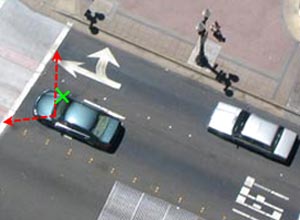Reference Points
Welcome To Our Quick & Easy Driving Information Guide
Drivers can't see the actual position of the car in relation to the roadway because the drivers view of the road is blocked by the dashboard and hood of the car. Good reference points help you overcome vision problems you encounter. To know the vehicle location (e.g., if the vehicle is aligned with the other vehicle when parking) a driver can align some part of the vehicle with the roadway.
Reference points are visual guides to help you judge your distance when parking or turning. From your viewpoint behind the steering wheel, reference points help you to see the exact location of the wheels, both front and back bumpers, and also the side of the car when parking or turning.
From the drivers seat, choose a reference point to be a visual mark of a specific place on your car that you can relate to some part of the roadway. The purpose in choosing these visual reference points is to know where your car is actually located on the road.

When parking next to a curb on the right, the center-hood ornament or the center of the hood works as a good reference point to tell where the right tires are located. When the line of the curb appears to intersect the center of the hood, your car's right tires will be positioned about 3-6 inches away from the curb.

When you want to know how far forward you can pull into a parking space or where to stop at an intersection, you will need to determine where the front of your car ends, i.e., where your car's front limitation is. You would drive forward until the curb or line ahead appeared to intersect under the passenger's side mirror. This is when the front of your car will be even with the curb line ahead.
© 1997-2025 DriversEd.com. All rights reserved. Please see our privacy policy for more details.






